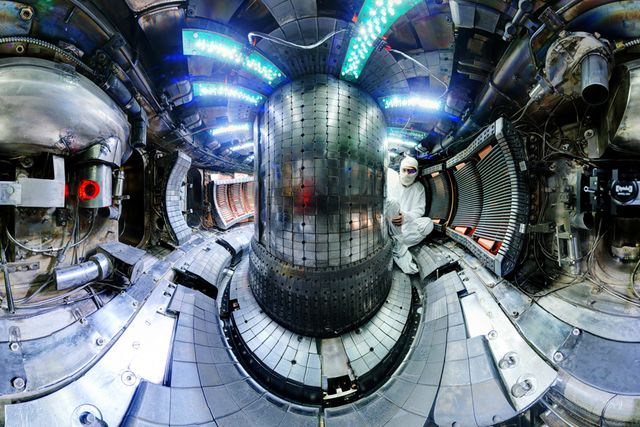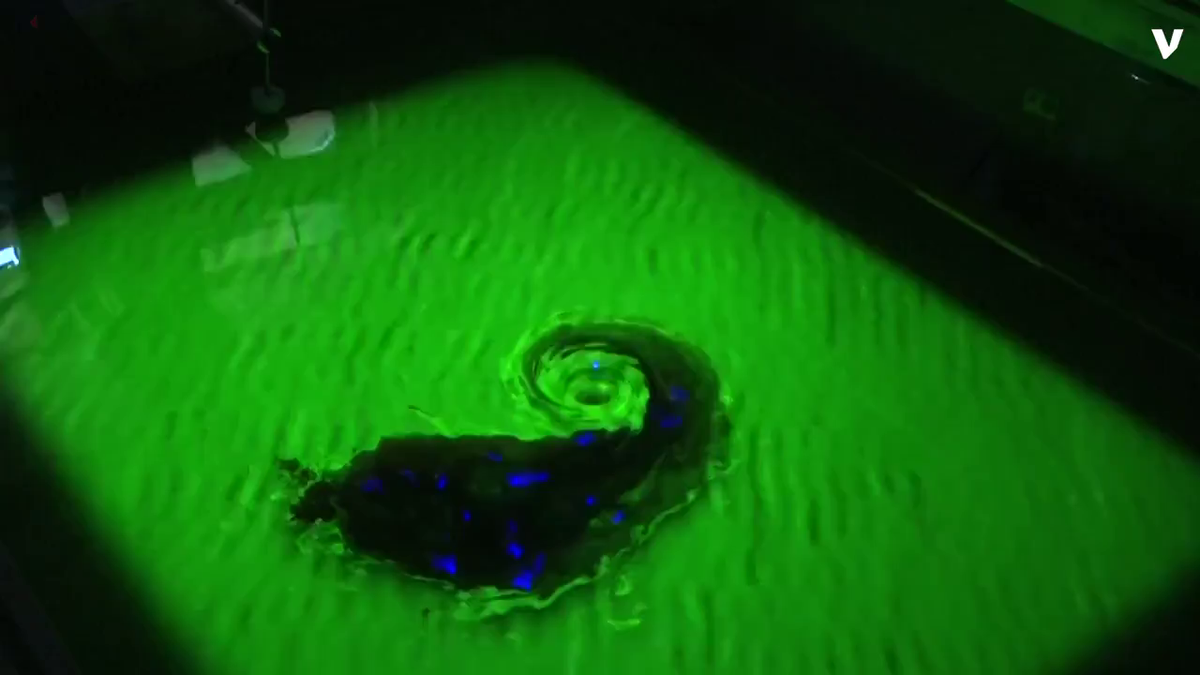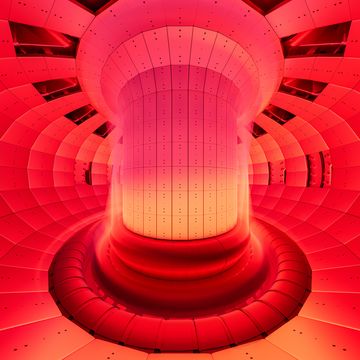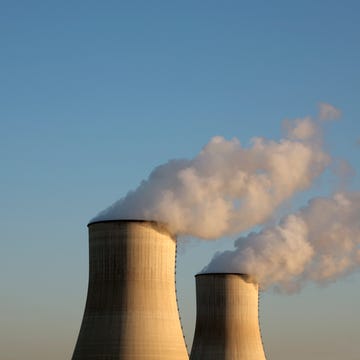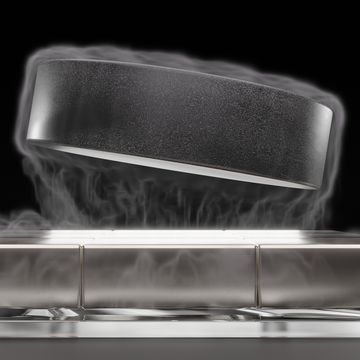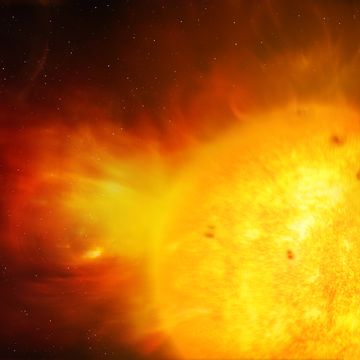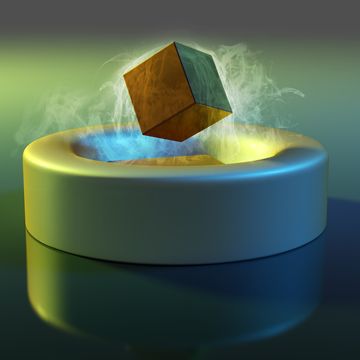Researchers operating fusion reactor experiments at MIT, along with partnered scientists in Brussels and the U.K., have developed a new type of nuclear fusion fuel that produces ten times as much energy from energized ions as previously achieved. The experiments with the new fusion fuel, which contains three types of ions—particles with an electric charge due to the loss or gain of an electron—were conducted in MIT's Alcator C-Mod tokamak, a magnetic confinement reactor that holds the records for highest magnetic field strength and highest plasma pressure in a fusion experiment.
The Alcator C-Mod conducted its final run in September 2016, but data from experiments in the tokamak device were recently analyzed, revealing a unique type of nuclear fusion fuel greatly increases ion energies within the plasma. The results were so encouraging that researchers operating the Joint European Torus (JET) in Oxfordshire, U.K., the largest operational magnetic confinement fusion experiment in the world, repeated the experiments and achieved the same increases in energy generation. A study detailing the findings was recently published in Nature Physics.
The key to increasing the efficiency of the nuclear fuel was to add in trace amounts of helium-3, a stable isotope of helium that only has one neutron rather than two. The nuclear fuel used in the Alcator C-Mod previously contained just two types of ions, deuterium and hydrogen. Deuterium, a stable isotope of hydrogen with one neutron in its nucleus—compared to common hydrogen which has no neutrons—accounts for about 95 percent of the fuel.
While industrial magnets suspend the fuel and hold it in place, the researchers at MIT's Plasma Science and Fusion Center (PSFC) used a process called radio-frequency heating to ignite the nuclear fuel. Antennas outside the tokamak use a specific frequency of radio waves to excite the particles. The radio waves are calibrated to target just the less abundant material, in this case hydrogen ions. Because the hydrogen accounts for a small fraction of the fuel's total density, focusing the radio-frequency heating on the minority ions allows them to reach extreme energy levels. The excited hydrogen ions then slam into the more abundant deuterium ions, and resulting particles fly into the reactor's outer shell, generating heat and electricity.
Researchers improved the efficiency of this process by adding helium-3 ions to the mix. The new fuel contains less than one percent helium-3. By focusing all the radio-frequency heating on this trace amount of helium-3, the researchers raised the ions to megaelectronvolt (MeV) energies. An electronvolt is the amount of energy gained or lost when a single electron jumps from a point of electric potential to a point one volt higher, a common unit of measurement for fusion experiments. The new results with helium-3 fuel, generating ions that reach megaelectronvolt energies, has never been achieved before, and the increase in ion energy is a full order of magnitude higher than previous efforts.
The Alcator C-Mod and JET are nuclear fusion experiments with the the capability to reach the same plasma pressures and temperatures that would be required in a full-scale fusion reactor, though they are smaller and do not produce what researchers call "activated fusion"—fusion from which energy is actually converted into power for use. Tweaking the fuel composition, radio wave heating frequencies, magnetic fields, and other variables in these fusion experiments allows researchers to dial in the most efficient fusion process possible before attempting the reaction on an industrial scale.
"These higher energy ranges are in the same range as activated fusion products," said MIT fusion research scientist John C. Wright. "To be able to create such energetic ions in a non-activated device—not doing a huge amount of fusion—is beneficial, because we can study how ions with energies comparable to fusion reaction products behave, how well they would be confined."
The MIT data from the Alcator C-Mod encouraged nuclear fusion researchers at JET to conduct experiments with the same type of fusion fuel. Not only did the British researchers at JET achieve the same results, but the two fusion experiments were able to measure different properties of the incredibly complex reactions occurring in the superheated plasma. At MIT, fusion scientists used a process known as phase contrast imaging (PCI) to accurately measure interactions between the fuel particles and the radio waves, while the JET scientists had the capability to more precisely measure the energy of MeV particles. The resulting picture of what happens during the fusion reactions is more complete than either facility could have achieved on its own.
"The JET folks had really good energetic particle diagnostics, so they could directly measure these high energy ions and verify that they were indeed there," says Wright. "The fact that we had a basic theory realized on two different devices on two continents came together to produce a strong paper."
Nuclear fusion has the potential to revolutionize energy production, with virtually endless power available from common elements like hydrogen and helium and no dangerous waste products produced as a result. Experiments like the Alcator C-Mod and JET inch us closer and closer to cracking the code, using the right fuel, and producing the conditions to spark a full-scale, energy-positive fusion reaction.
As the paper in Nature notes, the findings from these experiments could also help astronomers better understand helium-3 abundant solar flares that erupt from the sun, because that is literally what these fusion researchers are trying to do—ignite nuclear fusion in plasma that is hundreds of millions of degrees, similar to what stars are made of, trap it, and then power the world with the resulting energy.
Source: MIT

Jay Bennett is the associate editor of PopularMechanics.com. He has also written for Smithsonian, Popular Science and Outside Magazine.
